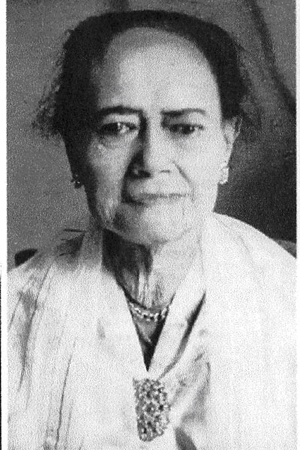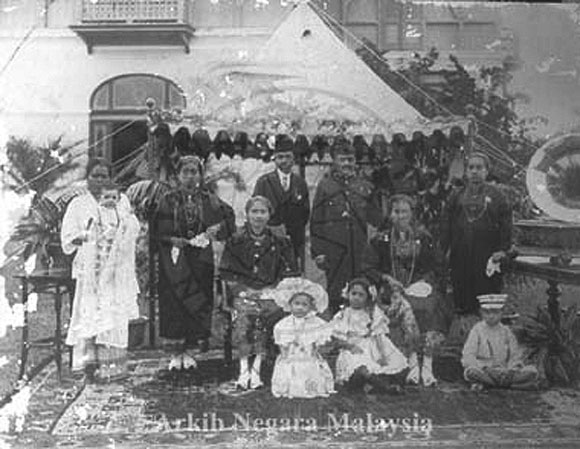The Innocent Sultan of Perak in the Seychelles
By Julien Durup, a student of history
On the early morning of 21 July 1877, Abdullah Jaafar Moratham, the Sultan of Perak, left his prison with his entourage, and boarded the iron steamship Cotherstone mastered by Captain Blanche. They leftSingapore for Abdullah’s exile in the Seychelles. They were escorted during the journey by Police Inspector R. Strugnell who acted as interpreter, along with eight other policemen.
The group arrived at Mahé on 31 August 1877, with their wives, families and servants. His followers were: Mantri Ibrahim bin Jaafar, Laxamana Mohamed Amin bin Wkafl and Shahbander Kadek bin Mohamed. Records in the Seychelles National Archives about their arrivals and early days in the Seychelles are sketchy. Little is being done to request relevant documents from Malaysia, or the Public Records Office in England, or Mauritius. There are no complete records of the names of those who arrived. History is vague even about their abodes of banishment as well as data about their number which was estimated to be about 37.
Some say at first they stayed at Union Vale, Mahé, in a huge house with a lot of annexes and later were all sent to Félicité Island, next to La Digue. According to hearsay, they resided in the following different locations in Mahé: Bel Etang, where the Seychelles College was; Rochon; Port Victoria, near the present Bahai Centre; Union Vale and Ma Constance at Anse Etoile, the former huge mansion of the famous corsair Jean François Hodoul.

Raja Mansur and his father Sultan Abdullah: Photo taken in London in 1894.
Source: Seychelles National Archives.
According to our good friend William McAteer: 2000, p.148, only two of his followers, the Mantri and Laxamana, were deported to Félicité Island. They were exiled there by Charles Salmon, (the good Catholic) Chief Civil Commissioner, and according to him he did so for security reasons which he did not fully explain. Salmon also recruited two more interpreters from Mauritius. In 1879, after two years of strict isolation with a lack of water and medical care, Captain Arthur Havelock, the new Chief Civil Commissioner allowed them to move to Mahé. However, sadly, history does say not how many of their families, servants and security personel were on Félicité Island.
Police Inspector R. Strugnel, who was suspended in Perak for cruelty committed against Malay prisoners, managed at the last minute to be recruited as body guard and interpreter to escort the Sultan to the Seychelles. In the Seychelles, he persuaded Salmon to take away the Sultan’s Keris or Kris (a traditional Malay dagger and part of his spiritual regalia) and left it with the police. This must have upset the Sultan as he was allowed to keep a sword given to him by Queen Victoria. It seemed that the Sultan never showed any grudge against Strugnel, as they played sports together, especially cricket.
During his exile, the Sultan became a very keen sportsman, a collector of beautiful walking sticks, and was also interested in agriculture. He introduced many types of fruits from Malaysia e.g. Manbolo (Mabolo), velvet apple, Diospyros discolour; Mangoustan, Garcinia mangostana, because of its exceptional alimentation properties, and that fruit is known as the queen of the fruits and the food of the gods in the Antilles. He also introduced banane mille (thousand), a type of banana from Malaysia that can produce 1000 bananas in a bunch. As a sportsman, he took part in cerf-volant (kite) competition, football, and was a very good at cricket.
In 1883, as a member of the Victoria Cricket Club, he played cricket with the Chief Civil Commissioner, the Chief Justice etc... and all the elite class. They played regularly and against visiting British man-of-war ship personnel. After integrating into the local society he won their hearts, and they signed petitions for his release. In one of the petitions he had the support of the new administrator, Thomas Risely Griffith. He also had support from Mauritius for his release where prominent Mauritians also signed a petition on his behalf.
In the Seychelles he had seven children, four sons and three daughters and lost one of his wives. The sons started their studies at the Government Boys School in Victoria and the daughters at the Saint Paul’s School, also at Victoria. One of his daughters, Rajah Hadyah Abdullah, born at Victoria on 4 August 1883, learned the piano at Mahé and later became an ardent pianist.

Rajah Hadyah Abdullah the pianist, the Sultan’s first daughter born in the Seychelles.
(Photo taken in 1961).
She played La Rosalie accompanied by one of her brothers, Raja Chulan, who was a violinist and consistently learned and played that tune in Mahé. According to Hadyah, a French band in the Seychelles gave a weekly public performance and played La Rosalie at the seafront of the Sultan’s residence. Presumably she was referring to Union Vale in Mahé which was one of the domiciles of the Sultan. After his visit to the Seychelles, Raja Chulan, introduced the melody to his brother, Raja Manaur, the Sultan’s eldest son. Later Mansur wrote the lyrics, and as his father’s secretary, he took it with them when they visited England where it was played for the first time as Perak National Anthem. The tune of the latter became the “Negaraku”, My Country, the National Anthem of Malaysia.
In the early 1960,s the French Ambassador in Kuala Lumpur, Monsieur Pierre Anthonioz, took an interest in the Negaraku. In 1964he sent a copy of the record to then British Governor of the Seychelles. The record was played regularly on the radio and was recognised by the old flock as the tune of La Rosalie, one of Pierre Jean de Beranger’s songs:
- La Rosalie assise par sa fenêtre,
- J’entends la pluie qui verse sur son dos,
- Son petit cœur qui réponse a son aise,
- Et le mien qui n’à point de repos.
On 16 April 1891, at Port Victoria, the Sultan wrote the following sad letter to his friend, Sir Henniker Heaton, the postal reformer, the Conservative MP for Canterbury, who visited him in the Seychelles:
“It is my melancholy duty to have to announce you the lamented death of my wife, which took place on Easter day at 8 a m: she leaves behind her several children to bewail her loss.
This is to me all additional sorrow. Before this sad event I have been deploring my situation as an exiled man; now I have to deplore the loss of my wife. I think it is the will of the Almighty, and I therefore resign myself to him. Bearing in mind the Latin maxim “Per ardua libertas” (to freedom through difficulties).
With my kindest regards
Sultan Abdullah
Ex-Sultan of Perak.”
That letter guided us to identify for the first time his wife’s date of death even though he did not specify her name and the date of death. Easter day of 1891 was on the 29 March. Therefore, she died and was buried on that day and her name was Che Rashia, (localy known as Princesse Rashia). That date is very important in the Muslim calendar in the Seychelles because it was on that date that the Muslim cemetery at Mont Fleuri was officially opened. During 1887 to 1893, four persons from Perak died at Mahé who, presumably, were among the deportees.
The Banane mille that the Sultan introduced contributed to the economy of the Seychelles. It was a type of banana that is resistant to disease; it became the commonest type of banana and contributed in nourishing the population during the two great wars. It seemed that the Sultan was well versed with the Koran, because he did not force his wives and daughters to use the burka, or cover their heads, which is, un-Islamic and predates Islam. If he were alive today he would have laughed seeing Seychellois women wearing burka.
Sultan Abdullah (in uniform) with members of his family in Singapore after their return from exile in the Seychelles,?c.1894. (Source: Arkib Negara Malaysia)
History is silent on Ally, one of the Sultan’s servants. Ally was faithful, quiet and peaceful. However, in 1885, he was wrongly convicted of killing like his master, and spent 13 years in prison. The main reasons for his conviction was that he was living close to a deceased person, and according to the court he should have heard the noise during the killing. According to oral tradition, the original place where the body was found was not in situ. The crime was committed by somebody else away from the house and the body was moved to a place under the bridge next to Ally’s domicile. Ally was released in 1898 and was not repatriated back to his home land. He died in the Seychelles and it is alleged that he has left descendants on the islands.
Reasons for his deportation
In 1875 Sultan Abdullah was accused of being involved in the murder of the first British resident in Perak, James Wheeler Woodford Birch. That murder precipitated a war in which the British used the Gurkhas for their first active service abroad. That war left nearly all eminent Malay officials dead or exiled. Right from his arrest and throughout his long deportation in the Seychelles and later Singapore, which lasted over twenty five years, this amiable and passionate man never stopped claiming his innocence. The British knew that he was innocent and refused to take the opinion of Sir Peter Benson Maxwell, the Chief Justice of the Straits Settlement, whose counsel was that the Sultan was not guilty to the charge which resulted into his sentence.
The man who was to blame for Birch’ murder was Sir Andrew Clarke, the governor of the Straits Settlements from 1873 to 1878. Clarke, who was about to retire, did not want that problem to destroy his reputations as one of the most successful colonial administrators. He disregarded the complaint that Sultan Abdullah wrote in a letter to him about Birch’s rudeness against the Malay rulers. Birch was arrogant and disrespectful of local customs of the ruling Sultan of Perak; he refused to remove his shoes when he entered the palace. After nearly a year in office he was killed.
Clarke was famously known for signing the Treaty of Pangkor in 1875 which established indirect British rule over the Malay States. That treaty was a turning point in the history of Malaysia. It gave the British the great opportunity to expand its influence in Southeast Asia and fortified its monopoly on tin.
References and a special thank you goes to Mrs. Heulwen Pool, for her help in tracing the names of Sultan’s children born in the Seychelles and the date of death of his wife.
- William McAteer: Hard Times In Paradise, 200, pp. 147-152
- Pool and Johnstone: Birth records from the Seychelles National Archives.
- John Calais: F/2.14, Vol. II p. 56 Seychelles National Archives.
- C/SS/2; B/37 and B/42 Seychelles National Archives.
- Sultan’s return from the Seychelles 1894: Sembangkuala wordpress.com
- The life and letter of Sir John Henniker Heaton. BT
- The Perak’s Chiefs, in the Straits Times newspaper, 21 July 1877.
- Ex-Sultan Abdullah of Perak. Hansard 19-2 1891 and 10 March 1892.
- The Bright Moon. stomachofchaos.com
- Dianna Salabert: Exiles in the Sun, 1994.
- Généalogie dans les iles de l’Océan Indien: Henri Maurel’s website.



